How G2 and NewBreed Built A High-Impact Three-Way GTM Partnerships With HubSpot
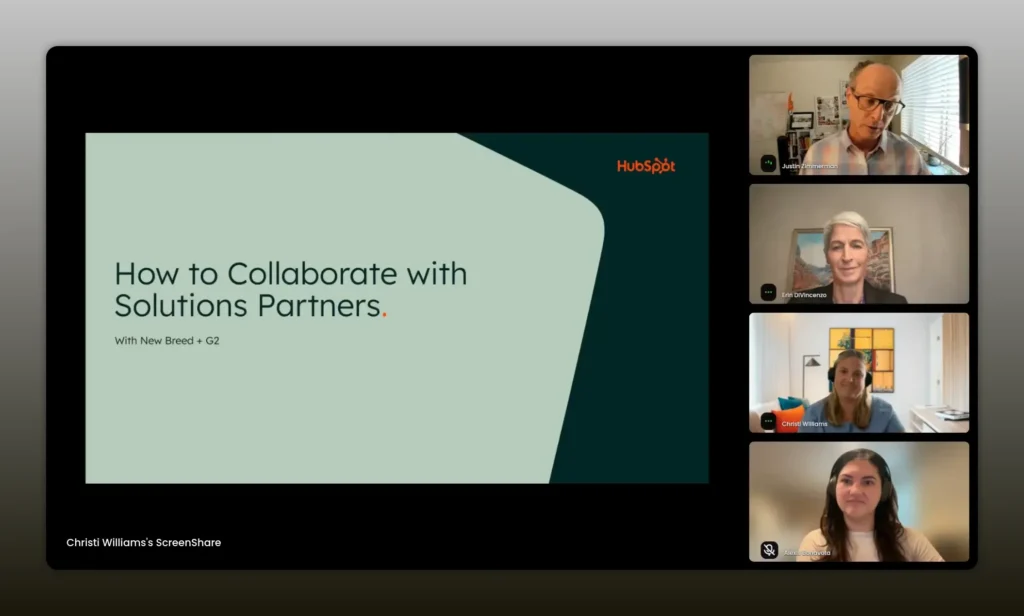
Featuring expert advice from Erin DiVincenzo, Christi Williams, and Alexis Bonavoto.
Introduction
Partnering well can multiply your product’s value, accelerate sales cycles, and dramatically improve retention. The biggest missed opportunity is not a lack of potential partners but a lack of a repeatable approach that aligns product, services, and customer outcomes. When an app partner, a solutions partner, and a platform team align around customer value, the result is a seamless experience that customers remember and renew.
Customer value has to be your North Star—get that right and the revenue and retention will follow. — Christi Williams
Table of Contents
- Why collaborating with solutions partners matters
- How to identify the right solutions partners
- Partnership models and where to start
- Operational best practices for co-selling and co-marketing
- Mapping the customer workflow together
- The three-way partnership case study: G2, New Breed, and HubSpot
- Quarter-by-quarter playbook to operationalize collaboration
- Tactical ideas for early wins and low-friction integrations
- How to surface champions and build internal buy-in
- KPIs and how to hold one another accountable
- Common pitfalls and how to avoid them
- Templates and assets to create before you launch
- Scaling your partnership playbook
- FAQs
- Conclusion
Why collaborating with solutions partners matters
You sell a product. Your customers buy outcomes. Solutions partners are the people who turn your product into those outcomes. They implement, optimize, and help customers extract value from the platform and your integration. That makes customers stickier and often raises average deal size and lifetime value.
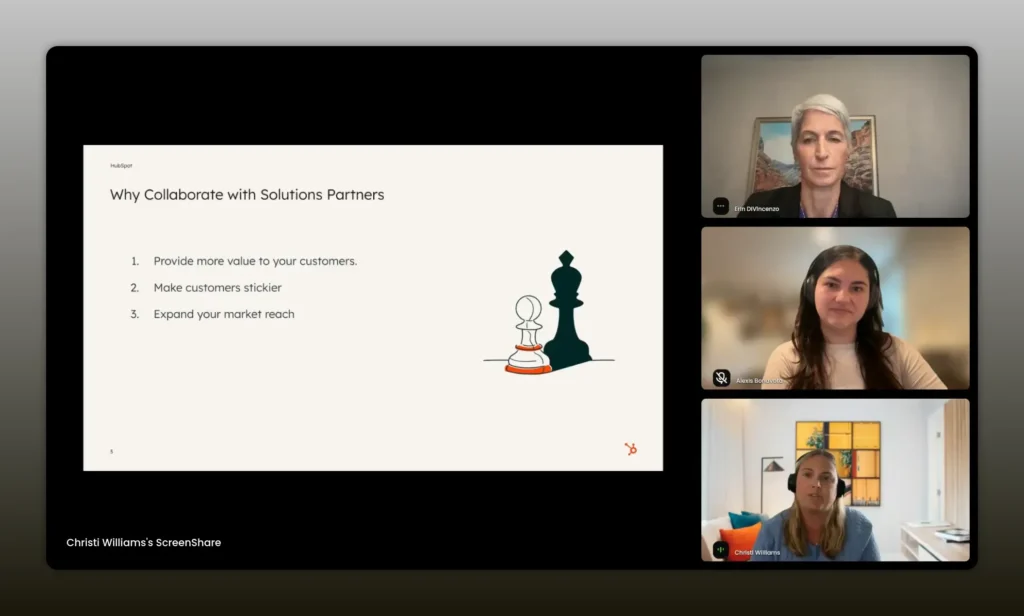
Solutions partners bring three major advantages:
- Deeper customer value — partners know how to configure HubSpot and adjacent systems to make your integration sing.
- Stronger retention — services that improve product usage and outcomes reduce churn and increase Net Dollar Retention.
- Expanded market reach — partners open doors into their customer base and can introduce you through co-marketing or referral programs.
Christi Williams emphasizes that these benefits compound: when solutions partners help customers realize the value of both HubSpot and an integrated app, retention improves for both the app vendor and the solutions partner.
How to identify the right solutions partners
You need a simple but thorough checklist to evaluate potential partners. Don’t rely on one signal. The strongest partnerships combine customer overlap, go-to-market fit, and cultural compatibility.
Priorities to evaluate:
- Mutual Ideal Customer Profile (ICP) — overlapping industries, company sizes, and personas (for example, customer service, sales ops, or marketing leaders).
- Pain point alignment — do their services fill gaps your product can’t? Do your capabilities plug holes in their delivery?
- Market segment alignment — SMB, mid-market, or enterprise. Targeting different segments can lead to mismatched expectations and pricing.
- Geography and language — regional focus matters for sales motions and support coverage.
- Evidence of domain expertise — are they publishing content or leading workshops about the platform you integrate with?
One of the most underused tactics to find partners is to ask your customers. Who do they already work with? Who do they follow on LinkedIn? Customers are a living map of potential partner fit.
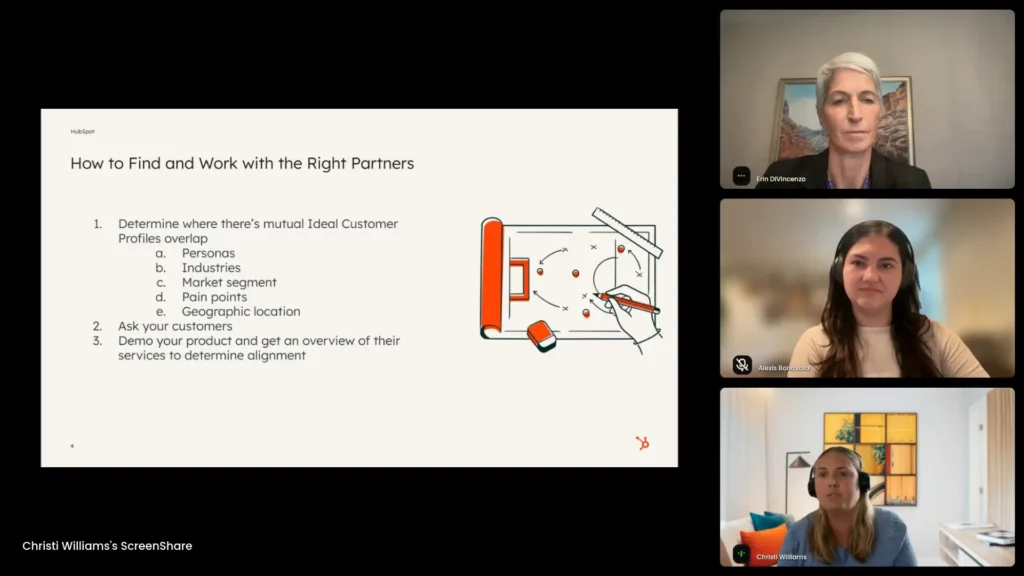
Partnership models and where to start
Partnerships come in layers. Pick the right layer for the problem you are solving and the amount of effort you can commit.
- Referral partnerships — low friction. The solutions partner recommends your product when appropriate. Use this model to start testing fit with minimal operational overhead.
- Co-marketing partnerships — shared webinars, joint content, and social amplification. Great to build awareness and credibility.
- Co-selling partnerships — deeper collaboration where sales teams coordinate and sometimes close together. This requires enablement and shared sales plays.
- Co-delivery or packaged services — the highest touch model. Partners bundle your product with their services into a consumable offering. Expect higher ROI and longer customer lifecycles, but also more operational complexity.
Start with one partner, shake out the process, and then rinse and repeat. Trying to sign every partner at once dilutes effort and slows momentum.
Operational best practices for co-selling and co-marketing
You can have the right partner and an excellent product, but without execution the partnership stalls. Use these practical rules to keep the partnership moving.
- Make customer value the North Star — every activity should be justified by how it improves the customer’s outcome.
- Define roles, responsibilities, and KPIs upfront — who creates content, who owns leads, and what success looks like for each campaign.
- Set up lightweight communication channels — external Slack channels, weekly check-ins, or shared project boards reduce friction.
- Enable both sales and delivery teams — run cross-company training so both sides can speak confidently about each other’s value props.
- Be selective and focused — pilot one packaged offering or one joint play before expanding.
Mapping the customer workflow together
You must map the customer’s journey from trigger to value. A shared workflow reveals gaps, moments of overlap, and natural handoffs.
- Trigger — what event or pain makes a buyer consider your solution? Examples include poor lead conversion, low product adoption, or a need for account-based motion.
- Research stage — where does the buyer go? Which content do they consume? Understand the search terms and resources they use.
- Evaluation — what proofs, demos, or pilot results do they need to commit?
- Activation — who configures the product and how long does it take?
- Value realization — what metrics show that the investment worked? Define the signals that indicate success.
After mapping, assign ownership for each step. A solutions partner might own activation and early value realization while you own product enablement and integration support. This clarity prevents dropped handoffs.
The three-way partnership case study: G2, New Breed, and HubSpot
A concrete example helps. G2 (a data company that powers software discovery) partnered with New Breed (a HubSpot solutions partner) with HubSpot as the shared platform. The collaboration focused on turning intent data into actionable, measurable outcomes.
When you combine a platform, data, and implementation expertise, you unlock a flight-ready solution: HubSpot is the aircraft for orchestration, G2 supplies the fuel in the form of intent data, and New Breed pilots the plane by configuring HubSpot and enabling sales and marketing motions.

HubSpot solutions partners are experts at implementing and optimizing HubSpot. That makes customers stickier. — Christi Williams
Why this pairing worked
G2 understands buyer intent and can surface signals that suggest who is in-market. New Breed knows how to interpret those signals within HubSpot and configure scoring, lists, and workflows that actually move accounts through the funnel. HubSpot provides the product and the platform to orchestrate that signal into action. Each party offered distinct but complementary value.

Make sure partnerships amplify your brand and fit into each other’s story. — Erin DiVincenzo
Common customer problems that created the opportunity
G2 heard the same phrase repeatedly: “I bought the data, now what?” Customers often lacked the resources or knowledge to:
- Configure ICPs, segments, and lead scoring
- Prioritize signals and reduce noise for sales teams
- Report on ROI and attribute outcomes to data investment
New Breed’s account-based marketing services and deep HubSpot expertise mapped directly to those needs. That created a clean value proposition for the joint offering.
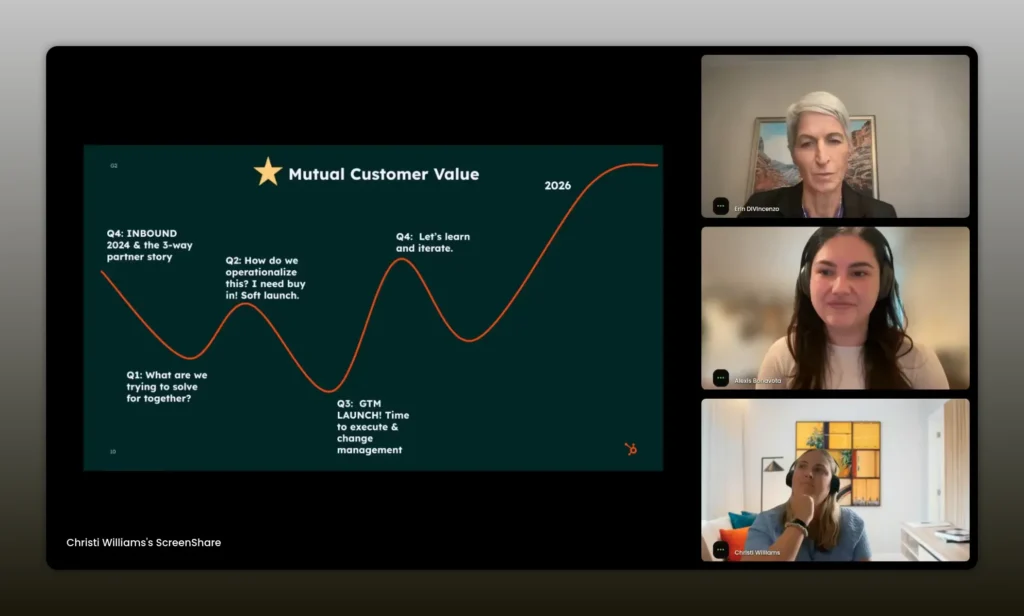
Keep your North Star metric focused on customer value. If that is clear, the revenue will follow. — Alexis Bonavoto
Quarter-by-quarter playbook to operationalize collaboration
The partnership between G2 and New Breed followed a staged approach that you can emulate. Expect ambiguity early and iteration throughout.
Q4: Ideation and vision
Start by sketching the art of the possible. Pull together your minimal list of use cases and identify the customer outcomes you want to impact. At this stage you should:
- Document the mutual ICP and target use cases
- List the data points or signals that matter
- Agree on the initial, tangible customer outcome to measure
Ideation doesn’t need to be perfect, but it needs enough clarity to pick a pilot that can be measured.
Q1: Align on “why” and learn each other’s business
Spend time understanding each other’s teams, processes, and seasons. Ask blunt questions: What internal resources can you allocate? When is each partner’s peak season? Who will own enablement and content?
The goal of Q1 is to build mutual trust and confirm that the pilot will address a real customer pain.
Q2: Package the offering and enable teams
Turn the pilot into a consumable product. New Breed packaged a service tailored for G2 customers that included configuration, scoring logic, and reporting so customers could see ROI quickly.
- Create a landing page or an internal FAQ for partner accounts
- Build a Slack channel or other quick communication path between teams
- Develop targeted enablement: short playbooks, a demo script, and a one-page pitch
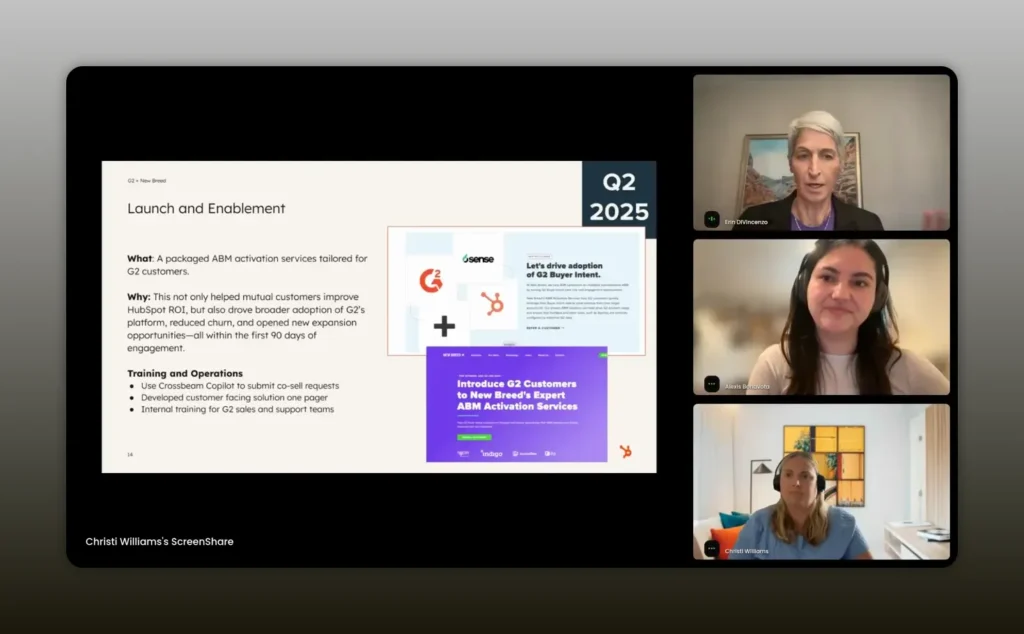
We became a G2 customer so we could walk in our clients’ shoes — credibility matters. — Erin DiVincenzo
Q3: Soft launches and low-friction pilots
Run a controlled set of pilots. Choose accounts that are likely to succeed and gather learnings. Use this phase to:
- Validate the customer workflow end-to-end
- Collect proof points and testimonials
- Refine handoffs between sales, solutions partner, and customer success
Q4: Go-to-market launch and iteration
With pilots proving the concept, launch public-facing content and events. New Breed and G2 co-created multi-city events and a growth lounge to showcase the joint narrative. Early co-marketing assets should be practical: a case study, a panel discussion, and a playbook for sales reps to use.
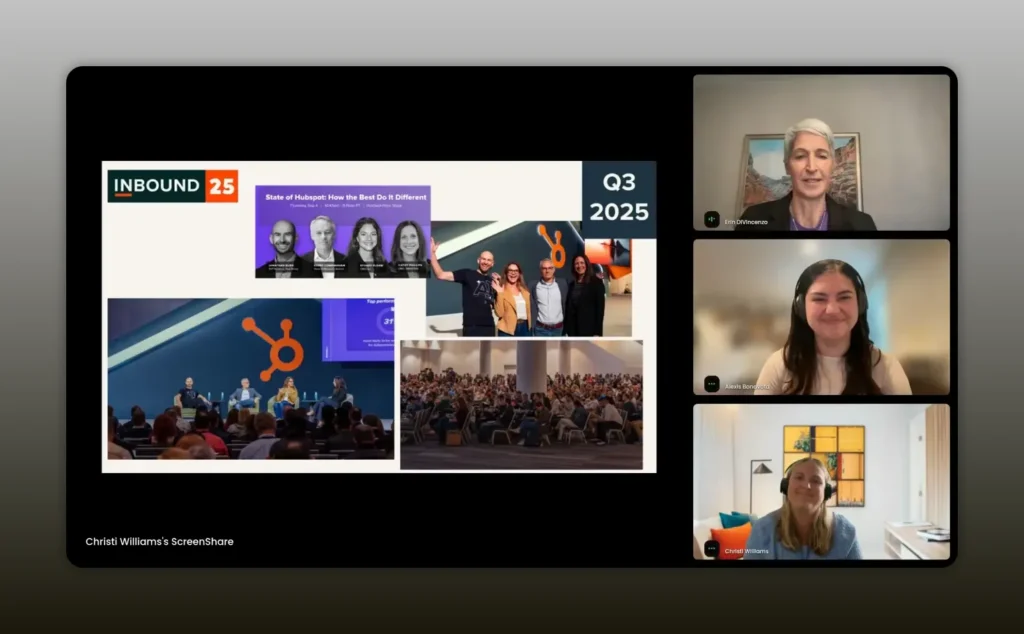
Finding low-hanging fruit where you can insert yourselves into each other’s go-to-market is critical. — Alexis Bonavoto
Tactical ideas for early wins and low-friction integrations
You don’t need to build a mega-program to get momentum. Try these small, high-impact tactics:
- Co-branded pilot offers — limited-time packaged services that are easy to buy and prove value fast.
- Shared enablement sessions — 30-minute demos for partner sales teams with an FAQ cheat sheet.
- Joint events or meetups — insert yourself in events your partner already runs to gain exposure with low lift.
- Shared Slack channel — immediate signal routing and rapid troubleshooting minimize delays.
- Customer walk-throughs — run a joint workshop with a mutual customer so both sides learn how to work together.
How to surface champions and build internal buy-in
Partnerships only scale when you have champions on both sides. Invest in relationship-building early and personally.
- Invite executive leaders to co-develop content — it creates ownership.
- Celebrate small wins publicly in joint channels — social proof fosters confidence.
- Enable frontline staff with short scripts and success stories they can spin into conversations.
- Give recognition to partner salespeople who refer clients — public kudos generate reciprocity.
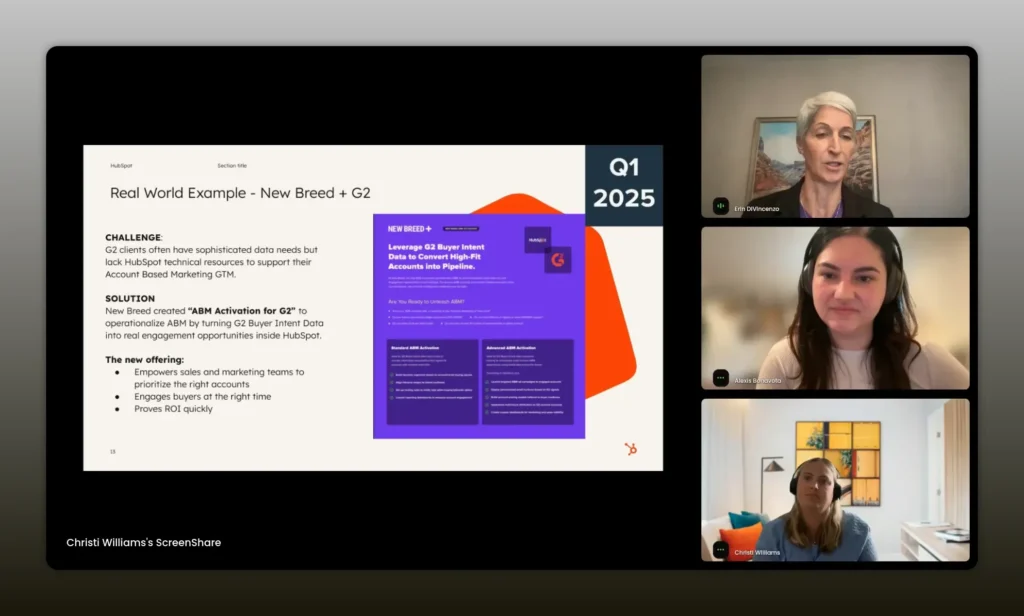
Leave your egos at the door and come to partnership with a helping mindset. — Erin DiVincenzo
KPIs and how to hold one another accountable
Define a small set of measurable KPIs. The metrics you choose will vary by partnership model, but common ones include:
- Influenced pipeline and sourced pipeline — credits for leads, demos, and opportunities.
- Close velocity and win rate — does the partnership shorten cycles or increase conversion?
- Average contract value — are joint offerings increasing ARR per customer?
- Customer activation time — how fast does a customer reach first value with the joint solution?
- Retention and NDR — long-term indicators of success.
Make KPIs visible in a shared dashboard and review them regularly. Keep the cadence short at first: weekly or biweekly until the process stabilizes.
Common pitfalls and how to avoid them
Partnerships fail for predictable reasons. Address these early.
- Lack of clarity — vague roles or success metrics lead to stalled execution. Define responsibilities and KPIs before launch.
- Perfection paralysis — waiting for a perfect launch loses momentum. Ship a validated pilot and iterate.
- Mismatched expectations — ensure commercial and operational expectations align. Discuss resource commitments candidly.
- No communication plan — set channels, frequency, and owners for updates and escalation.
- Overextending — chasing too many partners or too many GTM motions dilutes results. Focus and scale deliberately.
Templates and assets to create before you launch
Prepare a concise set of assets to reduce friction when onboarding partner teams:
- One-page value proposition specific to the partner
- Playbook for pre-sales conversations with objection handling
- Demo script that highlights where the solutions partner adds value
- Joint landing page or offer with clear next steps
- Internal FAQ and enablement recording
Scaling your partnership playbook
After you have one repeatable motion, create a lightweight framework to scale:
- Document the playbook — checklist, templates, and KPIs
- Train internal stakeholders — sales ops, demand gen, and CSMs should understand partner plays
- Standardize legal and commercial terms — reduce negotiation friction with standard MOU or referral terms
- Invest in partner success — a partner manager who can replicate the pilot with new partners
FAQs
How do I decide whether to start with a referral or a co-delivery partnership?
Start with the smallest viable interaction that proves customer value. If you see many joint wins from referrals but customers need help activating data or configurations, then iterate toward co-delivery. Use referrals to test fit and co-delivery to scale impact when the need and economics are clear.
What are the first three assets I should build for a pilot partnership?
Create a one-page joint value proposition, a 10-minute demo script that frames the combined solution, and a short enablement FAQ for the partner’s sales team. These items reduce friction and make it easy for partners to recommend your product.
How do we measure the ROI of a three-way partnership?
Tie ROI to customer outcomes: influenced pipeline, time-to-first-value, average contract value, and retention. Use a shared dashboard and agree on attribution rules before you launch so you can measure the pilot objectively.
How should tasks be split between an app company and a solutions partner during onboarding?
The app company should provide integration expertise, technical documentation, and product training. The solutions partner should focus on configuration tailored to the customer’s GTM (for example, scoring and segmentation), training for sales, and activation workflows. Document handoffs in the customer workflow map.
What governance cadence do you recommend for new partnerships?
Start with weekly tactical stand-ups and a monthly strategic review. Transition to biweekly or monthly tactical cadences as processes stabilize. Keep an open channel for immediate escalation and troubleshooting, such as an external Slack channel.
How do we keep the partnership equitable as it scales?
Revisit KPIs and commercial terms regularly. Create a revenue-sharing or referral credit model that reflects the actual work each party contributes. Maintain transparency through shared metrics and celebrate shared wins to reinforce reciprocal commitment.
Conclusion
Partnerships are not a black box. A repeatable, customer-first approach will convert curious conversations into measurable outcomes. Start small, define clear customer outcomes, enable both sales and delivery teams, and iterate. If you focus on mutual value and create a lightweight operational playbook, you can unlock far more than incremental revenue — you can create a product experience that keeps customers longer, increases deal sizes, and turns partners into growth engines.